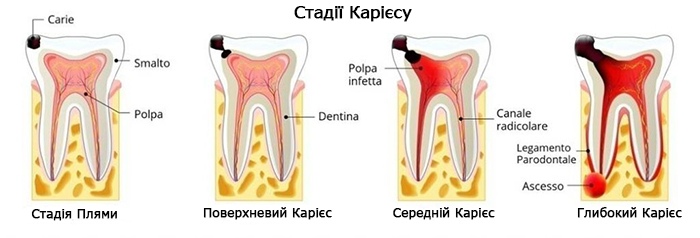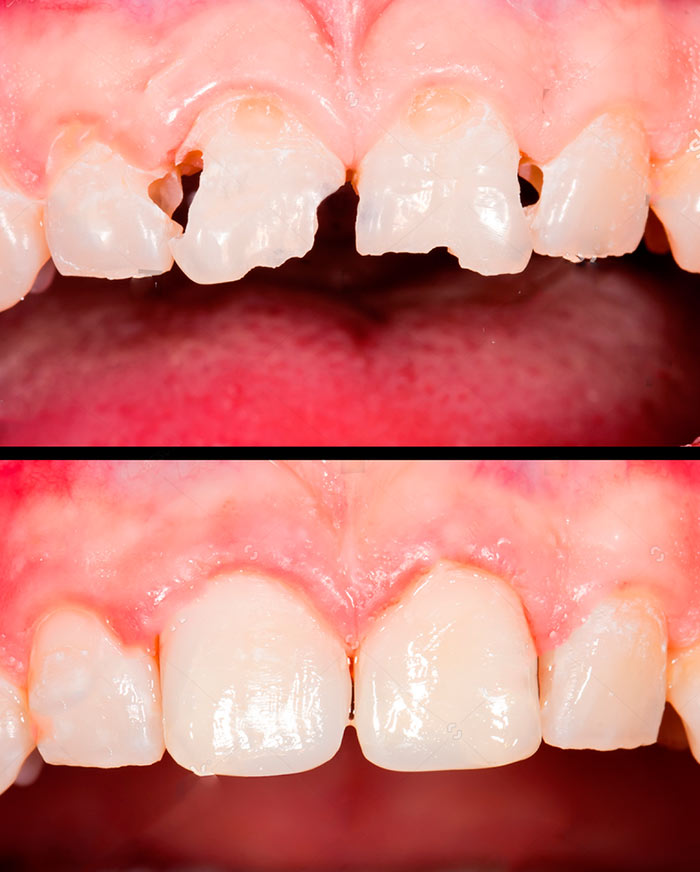Treatment of caries. Causes of caries and methods of treatment.
Our team has tried to collect all the information you need about what caries is, its causes and treatment methods, and presented it to you in a generally accessible and understandable language. We will try to dispel many myths about caries.
So, what is CAREER?
In simple terms, caries is "tooth decay" (Latin: caries 'rotting'). It is the destruction of tooth tissue caused by bacteria. Under the influence of these bacteria, the tooth loses all the necessary minerals (demineralization).
"It has been proven that 92% of Ukrainian teenagers already have caries, while in Europe this figure is only 40%."
Well, with such indicators, we are facing an "Epidemic of Toothlessness". Let's figure out what to do about this unfortunate caries.
Causes of caries
The main cause of tooth decay is poor or improper dental care. Not all people know how to brush their teeth properly and do so irregularly.
In the oral cavity there are so-called carcinogenic microorganisms - BACTERIA that process food residues in the mouth (carbohydrates) into organic acids. This acid affects any part of the tooth surface and causes DESTROYAL. First, the enamel is destroyed, then caries is formed.
"Did you know that enamel is close to diamond in strength and even exceeds it?!"
Stages of caries
There are 4 stages of caries:
Stained caries is the initial stage of caries when a stain appears on the tooth surface. This is due to the fact that the tooth enamel is damaged. Treatment at this stage is painless and quick. The enamel is restored.
"Often, the primary caries spot is not visible to the naked eye, and this is one of the reasons why you need to visit the dentist REGULARLY."
Superficial Caries - at this stage, the first obvious signs of caries appear and it is located within the tooth enamel.
Medium Caries is when the carious lesion of the tooth has reached the dentin. At the middle stage of caries, a person experiences pain, sensitivity to hot, cold, and sweet.
Deep Caries - this stage is the most painful and most advanced. The tooth rots to the "Pulp", in other words, to the "Tooth Nerve".

"Interesting: In all stages of caries, in parallel with the destruction of the tooth, natural recovery (mineralization) occurs, which occurs due to the action of saliva and the minerals contained in it "
Stages of caries treatment
Treatment of caries at the Stain stage.
First, caries is diagnosed using a methylene blue solution. This is a crystalline dye that stains only demineralized areas of the tooth. Then the tooth is dried with a stream of air and the 2nd layer of the solution is applied.
The point of treating caries at the stain stage is to saturate the tooth with the necessary minerals.
Our Dental Clinic uses only special modern preparations containing calcium, magnesium, etc., which are necessary for the restoration of tooth components.
Treatment of Deep, Medium and Superficial Caries.
Unfortunately, at such stages of caries, it is impossible to do without mechanical treatment of the tooth, because there is a carious cavity.
The treatment regimen is as follows:
- Tooth anesthesia - anesthesia is performed.
- The carious cavity is revealed - here, as we have already said, the tooth enamel is much harder than the "dentin" (the next component of the tooth) and it is destroyed less. We see one small black dot of caries on the tooth. This causes the overhanging edges of the enamel to form, which require mechanical treatment.
- Next, the carious cavity should be cleaned (necroectomy). Special dental instruments are used to remove softened dentin and necrotic tooth tissue.
- Then the process of forming a carious cavity takes place.
- And finally - Tooth filling
How to win the endless war against tooth decay?
Let us dispel a few myths and provide true statements about how not you need to take care of your teeth
Myth 1: "If you inherited teeth from your parents that are not prone to caries, they do not require careful care"
Genetics definitely matters, because people can inherit good factors for protecting their teeth, and this includes the chemical composition of saliva. But still, the most important thing is to take good care of your teeth.
Myth 2 "Children are most susceptible to caries"
And it's true! In fact, children are more susceptible to caries because they have a thinner enamel structure, wider dentinal canals, and caries penetrates the tooth much faster, and inflammatory processes occur quite quickly.
Myth 3 "It is useless to treat milk teeth, they will fall out anyway"
The most important thing to understand here is that behind the baby teeth, children grow permanent teeth - the beginnings of permanent teeth that are in close contact with the baby teeth. And if caries bacteria penetrate them, we can get a permanent tooth either with defects or so injure the tooth bud that the tooth will not erupt at all. It is worth noting that if we do not treat our teeth in time, it will be necessary to remove a milk tooth. This will result in the eruption of a permanent tooth in the wrong place. The child will need to wear braces, plates, and to straighten the bite in children.
Myth 4 "Losing one tooth does not harm other teeth"
This is a myth. With the loss of one tooth, the load on the maxillofacial apparatus is not distributed correctly. The teeth shift towards the cavity and the enamel is erased.
Myth 5: "If you bottle-feed your child for a long time, he or she may get tooth decay"
This is a true statement. The so-called "bottle tooth decay" Formula feeding contains more sugar than breast milk. Nighttime feedings are more important here, because at night the body is in a calm state and less saliva is secreted. And when saliva washes the tooth less, more bacteria accumulate on it. Therefore, we recommend drinking water after a nighttime bottle feeding. By the way, about dental treatment for pregnant women.
Myth 6 "Healthy teeth are white teeth"
In fact, no one's teeth are completely white. The color of a tooth depends on its internal structure called dentin. The color of the tooth depends on the yellowness of the dentin.
Myth 7 "You can get caries"
It is scientifically proven that you can get tooth decay! The main role in the development of tooth decay is played by bacteria, namely Streptococcus mutans - or mutating streptococcus. Like any other bacterium, streptococcus can be transmitted through saliva (kissing), sharing utensils, or using common toothbrushes. "Before you kiss, look into your partner's mouth - a little joke doesn't hurt :-)"
Oleksiuk Dentistry recommends taking proper care of your teeth, being under the supervision of a dentist, choosing the right toothbrush and the right hygiene products, including dental floss and mouthwash. And in the end, you will get a healthy smile. Our goal is to preserve your teeth. Smiling is easy with us!
Aesthetic dentistry is an artistic restoration of teeth.
Nowadays, along with the usual dental treatment, aesthetic dentistry has gained a high level of popularity. It allows you to restore even the most damaged teeth, overcome birth defects, etc. This type of dentistry includes a large number of different procedures. One of them is aesthetic dental restoration.
This process allows you to completely restore almost completely destroyed teeth and return a beautiful smile to a person. There are several types of this procedure, but the most effective is the artistic one. It, in turn, is divided into direct and indirect.
Why do you need dental restoration?
Modern aesthetic dentistry clinics offer their clients the procedure of artistic tooth restoration. However, not everyone knows what it is and why such a procedure is needed. Artistic dental restoration is essentially a type of prosthetics. The technique allows you to eliminate even the most complex defects and restore the integrity of the patient's teeth. This procedure is carried out through the use of various artificial materials. The complex of substances, selected for each patient individually, allows you to achieve the most natural shade of the tooth.
Depending on the complexity of the future restoration, the procedure can take place in several stages. Artistic restoration is used:
- In case of significant damage to the tooth enamel;
- In case of pronounced cracks in the teeth;
- When the color changes;
- To correct the bite;
- In case of significant trauma to one or more teeth.
Modern means of aesthetic dentistry allow you to completely restore even completely destroyed front teeth. Everyone who has used artistic dental restoration will regain a beautiful smile.
Direct artistic (aesthetic) restoration.

The technique of direct artistic restoration is used for non-critical minor tooth damage. This technique allows you to completely restore a damaged tooth in just one visit to the dental office. Direct artistic tooth restoration takes place in four stages:
- Preparatory stage - includes a preliminary examination by a dentist to determine the type of material to be used.
- Cleaning of the oral cavity and teeth - before restoration, the dentist performs a professional teeth cleaning for the patient. Depending on the individual characteristics of a person's tooth enamel and equipment, the dental office may use different cleaning methods (ultrasonic, laser, mechanical, etc.).
- Anesthesia - since the restoration is quite uncomfortable for the patient, anesthesia is administered. Therefore, we can say that the procedure is completely painless.
- The final stage is the recovery itself.
Indirect artistic restoration.

Indirect artistic restoration, which is often called external restoration, is used for minor damage and decay of teeth. It allows you to restore even a completely destroyed tooth. It is called external because most procedures take place without the patient's direct participation in the process: creating a prosthesis, fitting it to individual characteristics, etc.
The orthopedic structure is created according to the patient's jaw scan, which is a rather complicated process that can take several weeks. The most common material used in the process of indirect artistic tooth restoration is veneer. Compared to other materials, it has increased strength, excellent aesthetic appearance, and it is also quite easy to work with. Due to these advantages, in most cases of indirect restoration, veneers are used.
Veneers - what are they?
A veneer is an ordinary ceramic plate. The physical and operational characteristics of the material make it almost ideal for use in aesthetic dentistry. A distinctive feature of veneers is a rich color palette. This allows the dentist to choose the most suitable shade, which makes the prosthesis almost indistinguishable from a real tooth. Most patients who know at least something about the artistic restoration procedure ask for a veneer prosthesis when they visit the dental office. It allows them not to worry about the beauty of their smile.
How much does aesthetic dental restoration cost?
It is impossible to answer the question "how much does artistic tooth restoration cost" unequivocally. The final cost of the work depends on many factors, such as the condition and type of tooth, the material used, etc. However, in any case, it is highly discouraged to save on this procedure. If the price differs significantly in a downward direction, then most likely you will have the process made of low-quality material. It is not for nothing that they say that "beauty requires sacrifice", this also applies to a smile.